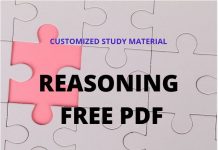 For Daily Job Alert For Daily Job Alert |
Join Our Whats App Channel |
 For Free Study Material For Free Study Material |
Join Our Telegram Channel |
Directions: Five statements given below, labeled as a,b,c,d and e. Among these, four statements are in logical error and form coherent paragraph/passage. From the given options choose the option that doesn’t fit into the theme of the passage.
- A. Midnight has an eerie and slightly occult hold on our imaginations.
B. It is the hour when magic is supposed to take place, when the old falls away and a new day arrives with one twitch of a clock’s minute-hand.
C. It is not feasible for India to progress through the 21st century with 19th-century administrative systems.
D. Midnight also has a sinister ring to it – it is the ‘witching hour’ when bad things happen, or when the knock on the door heralds the assassin or the secret police or the gang of abductors.
E. Or, as Eliot wrote, midnight’s lunar incantations “Dissolve the floors of memory/And all its clear relations,/Its divisions and precisions”. - A. Not only is there no one-to-one relationship between interest rates and investment, demonetisation has already done what a rate cut could hope to achieve.
B. Indeed, it has done what repeated signals from RBI have failed to do.
C. Add to this the fact that the US Fed is poised to raise rates at least once, if not twice, this year, liquidity is still surplus,
D. there are signs of asset price bubbles in some asset markets, and the case for a rate cut becomes much weaker.
E. But because it is using economic diplomacy to make more friends or at least transactional acquaintances. - A. Despite the positive propaganda, a lot of misinformation about GST is swirling in markets and homes.
B. Shops are trying to cash in with pre-GST clearance sales, although they can claim ‘transition credits’ on tax they have already paid on their inventories when GST kicks in.
C. Registered businesses are living in fear of having to file three GST returns a month, but Jaitley says after the first lot are loaded on the GST Network, the technology platform, two of the three returns will be ‘self-populating’ and require little work.
D. It is also a means to break walls between different government agencies and enable best practices being shared.
E. Most of all, there is fear that GST will raise prices across the board. - A. Of course, the government loses no opportunity to paint things in political colours, rather than with the broad brush of public good. Now they say there are reforms, but no job creation.
B. At a long Q&A on Tuesday, Jaitley complained that critics will not cease cavilling. “I think some people like to create controversies,” he said.
C. “In 2014 they complained that our reforms are incremental, not big-bang. That argument has been demolished by big-bang reforms like GST, demonetization and the insolvency and bankruptcy law.
D. The third reform has been the creation of an immense sense of competitive spirit among states and districts by ranking them, and increasingly selecting them for projects through a challenge method.
E. ” He said a lot of jobs are being created outside the formal sector, as in self-employment. - A. We believe that non-financial companies, too, would benefit from a more aggressive look at the risks they face.
B. Among the most important steps they could take, for example, would be to quantify risks in the context of broader scenarios, and not just as discrete sensitivities.
C. Administrative reforms will have to remain a continuous process, even as a lot has been achieved quietly in the last three years.
D. They should calculate the effect of more extreme one-off events, such as a cyber security attack, in addition to continuous risks, like GDP.
E. They should model risk-mitigation strategies as well as the risks themselves. - A. The End of Theory: Financial Crises, the Failure of Economics, and the Sweep of Human Interaction.
B. Ideally, VAT operates on the premise that components of the transaction chain will always locate each other.
C. In B2B transactions, set-off as input tax credit (ITC) is given for taxes paid on purchase against that levied on the corresponding sales.
D. Assuming a seller would like to understate sales and the corresponding purchaser to overstate purchase, the seller-purchaser duo will always have diametrically opposite intents.
E. This, in turn, would finally drive in a unique market-driven checks and balance mechanism to eventually ensure that VAT is successful. - A. It is an accounting of humanity, producing its ledger of debit and credit balances.
B. This formed the starting point of William Stanley Jevons’s Theory of Political Economy: a quantitative analysis of the feelings of pleasure and pain.
C. Of the seven Benthamite circumstances that are associated with pleasure and pain,
D. Jevons selected intensity and duration as the most fundamental dimensions of feeling.
E. the result is that they haven’t absorbed many of the lessons on risk management learnt by the financial sector. - A. So, finally, it looks like the goods and services tax (GST) will solve many of the problems that afflict the country’s indirect taxation system.
B. The quantity of feeling, then, is the product of its intensity and duration.
C. Not the least, the staggering fraud that the valueadded tax (VAT) as a method breathed into the system.
D. Managing evasion is a nightmare for any revenue administration.
E. Designing indirect tax, especially in a federal polity where taxing jurisdictions differ, had always been a difficult proposition for the tax architect. - A. Data shows ODIs issued against derivatives had a notional value of about Rs 40,165 crore — about 24 per cent of the total notional value of outstanding ODIs.
B. The new rules are in addition to enhanced disclosures to prevent P-notes misuse.
C. Non-resident Indians, for example, have been barred from using this route.
D. Reserve Bank of India (RBI) recently reported that the debt-to-state GDP ratio of as many as 17 Indian states increased in the past year.
E. Funds routed via P-notes now account for less than 6 per cent of the secondary market compared to about 50 per cent in 2004. - A. India is the only country in the world where structural reforms are taking place today.
B. In the decade since the global financial crisis, financial companies have honed their ability to measure risk in a way that non-financial companies have not.
But the result is that they haven’t absorbed many of the lessons on risk management learnt by the financial sector.
C. Granted, non-financial executives hadn’t faced the same existential crisis.
D. And they have seldom come under the same kinds of investor and regulatory pressure.
E. We believe that non-financial companies, too, would benefit from a more aggressive look at the risks they face.












